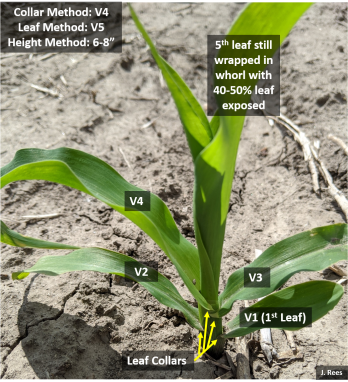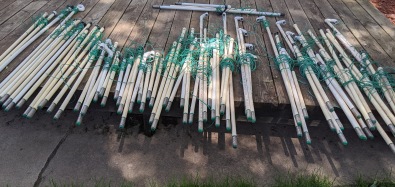June 3: Communicating with Farmers Under Stress webinar, 9 a.m., go.unl.edu/farmstress June 24: Weed Management Field Day, SCAL near Clay Center July 8: Palmer Amaranth Mgmt Field Day, near Carleton Aug. 11: Soybean Management Field Days, Hildreth Aug. 12: Soybean Management Field Days, Elgin Aug. 13: Soybean Management Field Days, Shelby Aug. 14: Soybean Management Field Days, Arlington Aug. 20: Midwest Soil Health Clinic, ENREC Aug. 25: SCAL Field Day, Clay Center Aug. 26: Midwest Soybean Production Clinic, ENREC Aug. 27: Midwest Corn Production Clinic, ENREC |
Corn: I really enjoy this stage when corn is just tall enough to give the fields a green cast when looking at them from an angle. There continues to be discussion and questions about uneven corn emergence. Like many, I wasn’t anticipating seeing uneven emergence after having great soil conditions (right moisture and a warming trend of temps) for planting. Variations in soil temp, depth, and moisture can delay germination from a few days or longer. Residue blowing back over the row explained much difference in emergence this year. I wish I would’ve noted the days on my calendar, but there’s a couple warm days in late April during planting where it just seemed like the moisture rapidly left the soil surface. And, in conversations it seems as if others noticed that too. So I think moisture around seed was another factor as was fertilizer burn in some situations. Purdue University has some research which showed yield reductions of 6-9% for plants emerging 1.5 weeks later than a uniformly emerging stand. They also found yields of uneven stands to be similar to planting the stand 1.5 weeks later.
If you’re side-dressing nitrogen and interested in testing different rates, we have some on-farm research protocols available at: https://go.unl.edu/tv63.

With warmer temperatures anticipated, corn will grow rapidly. This week we wrote an article in CropWatch regarding proper growth staging of plants; this will be extra critical once we hit V6+. Remember to use the leaf collar method and this is how I explain it. A collar develops at the leaf base near the stalk after each leaf fully expands. Think about collars like the collar on a button-down shirt. The collar flares slightly at one’s neck, just as a true exposed leaf collar flares at the base of the leaf at the stem. Start counting leaves at the base of the plant with the smallest rounded-tip leaf with a collar as #1. From there count every leaf with a true collar. Leaves that are still wrapped in the whorl around the main stem without exposed leaf collars are not counted. I recommend taking a picture inside the end rows to document the growth stage of your field prior to the post-application of herbicide. Next week I will share my experiences with proper growth staging to avoid ear abnormalities. Also be aware of potential off-target movement with dicamba products and higher temperatures.
Soybean: In most cases, soybeans are looking really good. There have been situations this week with herbicide damage to beans that may have been cracking when irrigation or rainfall event occurred allowing some pre-emergent herbicide to enter the row. Pre- herbicides can also rain splash onto cotyledons and first leaves making them look bad, but usually doesn’t kill them unless the weather stays cold and wet. If the plants end up severely pinched below the cotyledons, they won’t survive. Otherwise, keep watching them as they may continue to grow (warm weather will allow them to grow and metabolize the chemical better). I think we’re also possibly seeing some environmental effects from the cold conditions that occurred after planting/emergence when we can’t always explain the appearance of injury on the plant by herbicide. The ‘halo’ effect of ILeVo is another thing that is being mistaken as herbicide and/or environmental injury but it doesn’t last past the cotyledon stage.
Coronavirus Food Assistance Program for Crop Producers Webinar: There will be a webinar on June 4th at Noon (CST) to learn more. Registration is required at the following site: https://go.unl.edu/wj0e. In the meantime, Dr. Brad Lubben has put together an article with more information at: https://go.unl.edu/h3aq. All webinars are also archived at that same web link.
Irrigation Scheduling Equipment: It’s also a great time to get irrigation scheduling equipment installed! I decided to make a quick video instead of writing; it can be found at: https://youtu.be/4r5gn2pvvB4.

Sensors prepped and ready for 2020 on-farm research projects!
Gardeners: For all of you gardening for the first time, congrats! Some tips: keep soil moisture even by ensuring plants have around 1” of water/week (Best to water at base of plant; if use sprinkler, do so in early morning). Mulching gardens with leaves, grass clippings, straw, newspapers aids in conserving moisture, reducing weeds, and maintaining stable soil temperature. If herbicides were added to grass clippings, make sure to read the label for if/when they can be applied to a garden. In general, many labels will say grass clippings are safe after 4 mowings.


































